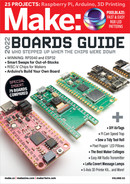
555 or 7555
1
2
3
4
8
7
6
5
Negative
ground
Positive
power
Discharge
Threshold
Notch
Control
Trigger
Dimple
Output
Reset
PROJECTS AM Radio Transmitter
from left to right.
The specification for 7555 chips varies slightly
from one manufacturer to another, but so far as
we know, all chips of this type will work in the
circuits in this experiment.
In Figure B, the square blue object with a white
circle on it is a 500K trimmer potentiometer —
that is, a variable resistor whose resistance you
can adjust from zero to 500,000 ohms by turning
the screw built into it. The pink dots show the
locations of pins under the trimmer.
TIP: Some trimmer potentiometers are not well
designed for use with breadboards. Their little pins
have kinks in them, which may be difficult to insert
fully, and the trimmer may tend to rise up out of
the board. You can overcome this tendency by using
pliers to straighten or flatten the pins.
Because we’ll be referring to some of the pins
on the 7555 timer by name, we have summarized
them in Figure
C
.
As soon as you apply 9VDC to the circuit and
switch it on, the timer emits a stream of pulses
from its Output pin. In the circuit, the pulses pass
through a 100-ohm resistor (to limit the current)
and a 100μF electrolytic capacitor (which blocks
DC) on their way to a speaker. The duration
of each positive pulse is determined by three
resistances: R1A, R2A, and P1. The gaps between
pulses are determined by R2A and P1. The size
of capacitor C1A also determines the duration of
the pulses and the gaps between them. Higher-
value resistances and/or higher capacitance
will generate longer pulses and gaps, so the
potentiometer will adjust the pulse stream.
TIP: If you want to know how to calculate the
results of resistance and capacitor values when
using a 555 or 7555 chip, search the web for “555
timer calculator.” Many calculators are available
online, and the values for a 555 timer will create
exactly the same frequencies as a 7555 timer. The
7555 just does the job better.
FREQUENCY AND WAVELENGTH
Figure
D
shows the actual output from the 7555
chip, displayed on the screen of an oscilloscope.
You don’t have to own an oscilloscope to build
and test the circuits here, but it will be extremely
useful, and some oscilloscopes are now almost
as cheap as multimeters.
Even though the output in Figure D consists of
straight lines, it’s known as a waveform. (This one
happens to be a square wave.)
The scale on the left in Figure D shows that
the output from the 7555 ranges from almost
exactly 0V to 9V, when you are using a 9VDC
power supply. This voltage will be pulled down
somewhat when you add a load to the Output pin
of the chip, such as a speaker. The oscilloscope
trace shown here was measured without a load.
The period of the output is a measurement of
time, from the start (or end) of one pulse to the
Charles Platt
The names of pins on a 555 or 7555 timer chip.
9VDC
7555
To
speaker
100µF
100
0.1µF
10K
500K
10K
10nF
10nF
7555
B
The breadboarded version of the circuit
shown in the schematic, Figure A.
C
64 makezine.com
M83_062-69_BookEx-Radio_F1.indd 64M83_062-69_BookEx-Radio_F1.indd 64 10/10/22 3:32 PM10/10/22 3:32 PM
..................Content has been hidden....................
You can't read the all page of ebook, please click here login for view all page.
